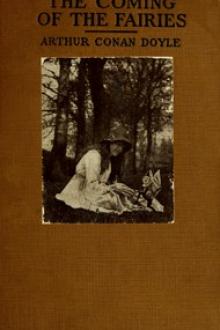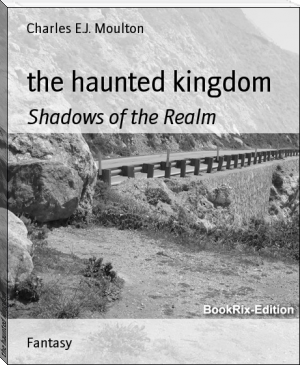The Coming of the Fairies, Arthur Conan Doyle [motivational novels .TXT] 📗

- Author: Arthur Conan Doyle
- Performer: -
Book online «The Coming of the Fairies, Arthur Conan Doyle [motivational novels .TXT] 📗». Author Arthur Conan Doyle
Fairy. A blue fairy. A fairy with wings and general colouring of sea-blue and pale pink. The wings are webbed and marked in varying colours like those of a butterfly. The form is perfectly modelled and practically nude. A golden star shines in the hair. The fairy is a director, though not apparently with any band for the present.
Fairy Band. There has suddenly arrived in the field a fairy director with a band of fairy people. Their arrival causes a bright radiance to shine in the field, visible to us sixty yards away. She is very autocratic and definite in her orders, holding unquestioned command. They spread themselves out into a gradually widening circle around her, and as they do so, a soft glow spreads out over the grass. They are actually vivifying and stimulating the growth in the field. This is a moving band which arrives in this field swinging high over the tree tops as if from a considerable distance. Inside a space of two minutes the circle has spread to approximately twelve feet wide and is wonderfully radiant with light. Each member of the band is connected to the leader by a thin stream of light. These streams are of different colour, though chiefly yellow, deepening to orange. They meet in the centre, merging in her aura, and there is a constant flow backwards and forwards among them. The form produced by this is something like an inverted fruit dish, with the central fairy as the stem, and the lines of light which flow in a graceful even curve forming the sides of the bowl. This party is in intense activity, as if it had much to do and little time in which to do it. The director is vivified and instructed from within herself, and appears to have her consciousness seated upon a more subtle plane than that upon which she is working.
Fairy. Elsie sees a tall and stately fairy come across the field to a clump of harebells. It is carrying in its arms something which may be a baby fairy, wrapped in gauzy substance. It lays this in the clump of harebells and kneels down as though stroking something, and after a time fades away. We catch impressions of four-footed creatures being ridden by winged figures who are thin and bend over their mounts like jockeys. It is no known animal which they bestride, having a face something like that of a caterpillar.
Amongst this fairy activity which appears all over the field, one glimpses an occasional gnome-like form walking with serious mien across the field, whilst the wood elves and other imp-like forms run about amongst their more seriously employed fairy kind. All three of us keep seeing weird creatures as of elemental essence.
Elsie sees about a dozen fairies moving towards us in a crescent-shaped flight. As they drew near she remarked with ecstasy upon their perfect beauty of form—even while she did so they became as ugly as sin, as if to give the lie to her words. They all leered at her and disappeared. In this episode it may be that one contacts a phase of the antagonism and dislike which so many of the fairy creatures feel for humans at this stage of evolution.
Frances saw seven wee fairies quite near—weird little figures—lying face downwards.
(In the Glen, 18th, 2 p.m.) Frances sees a fairy as big as herself, clothed in tights and a garment scalloped round the hips; the whole is tight-fitting and flesh-coloured; she has very large wings which she opens above her head; then she raises her arms from her side up above her head and waves them gracefully in the air. She has a very beautiful face with an expression as if inviting Frances into Fairyland. Her hair is apparently bobbed and her wings are transparent.
Golden Fairy. One specially beautiful one has a body clothed in iridescent shimmering golden light. She has tall wings, each of which is almost divided into upper and lower portions. The lower portion, which is smaller than the upper, appears to be elongated to a point like the wings of certain butterflies. She, too, is moving her arms and fluttering her wings. I can only describe her as a golden wonder. She smiles and clearly sees us. She places her finger on her lips. She remains watching us with smiling countenance in amongst the leaves and branches of the willow. She is not objectively visible on the physical plane. She points with her right hand, moving it in a circle round her feet, and I see a number, perhaps six or seven, cherubs (winged faces); these appear to be held in shape by some invisible will. She has cast a fairy spell over me completely subjugating the mental principle—leaves me staring wild-eyed in amongst the leaves and flowers.
An elf-like creature runs up the slanting branch of the willow from the ground where the fairy stands. He is not a very pleasant visitor—I should describe him as distinctly low class.
INDEPENDENT EVIDENCE FOR FAIRIES
By a curious coincidence, if it be indeed a coincidence, at the moment when the evidence for the actual existence of fairies was brought to my notice, I had just finished an article dealing with the subject, in which I gave particulars of a number of cases where such creatures were said to have been seen, and showed how very strong were the reasons for supposing that some such forms of life exist. I now reproduce this article, and I add to it another chapter containing fresh evidence which reached me after the publication of the photographs in the Strand Magazine.
We are accustomed to the idea of amphibious creatures who may dwell unseen and unknown in the depths of the waters, and then some day be spied sunning themselves upon a sandbank, whence they slip into the unseen once more. If such appearances were rare, and if it should so happen that some saw them more clearly than others, then a very pretty controversy would arise, for the sceptics would say, with every show of reason, "Our experience is that only land creatures live on the land, and we utterly refuse to believe in things which slip in and out of the water; if you will demonstrate them to us we will begin to consider the question." Faced by so reasonable an opposition, the others could only mutter that they had seen them with their own eyes, but that they could not command their movements. The sceptics would hold the field.
Something of the sort may exist in our psychic arrangements. One can well imagine that there is a dividing line, like the water edge, this line depending upon what we vaguely call a higher rate of vibrations. Taking the vibration theory as a working hypothesis, one could conceive that by raising or lowering the rate the creatures could move from one side to the other of this line of material visibility, as the tortoise moves from the water to the land, returning for refuge to invisibility as the reptile scuttles back to the surf. This, of course, is supposition, but intelligent supposition based on the available evidence is the pioneer of science, and it may be that the actual solution will be found in this direction. I am alluding now, not to spirit return, where seventy years of close observation has given us some sort of certain and definite laws, but rather to those fairy and phantom phenomena which have been endorsed by so many ages, and still even in these material days seem to break into some lives in the most unexpected fashion.
Victorian science would have left the world hard and clean and bare, like a landscape in the moon; but this science is in truth but a little light in the darkness, and outside that limited circle of definite knowledge we see the loom and shadow of gigantic and fantastic possibilities around us, throwing themselves continually across our consciousness in such ways that it is difficult to ignore them.
There is much curious evidence of varying value concerning these borderland forms, which come or go either in fact or imagination—the latter most frequently, no doubt. And yet there remains a residue which, by all human standards, should point to occasional fact. Lest I should be too diffuse, I limit myself in this essay to the fairies, and passing all the age-long tradition, which is so universal and consistent, come down to some modern instances which make one feel that this world is very much more complex than we had imagined, and that there may be upon its surface some very strange neighbours who will open up inconceivable lines of science for our posterity, especially if it should be made easier for them, by sympathy or other help, to emerge from the deep and manifest upon the margin.
Taking a large number of cases which lie before me, there are two points which are common to nearly all of them. One is that children claim to see these creatures far more frequently than adults. This may possibly come from greater sensitiveness of apprehension, or it may depend upon these little entities having less fear of molestation from the children. The other is, that more cases are recorded in which they have been seen in the still, shimmering hours of a very hot day than at any other time. "The action of the sun upon the brain," says the sceptic. Possibly—and also possibly not. If it were a question of raising the slower vibrations of our surroundings one could imagine that still, silent heat would be the very condition which might favour such a change. What is the mirage of the desert? What is that scene of hills and lakes which a whole caravan can see while it faces in a direction where for a thousand miles of desert there is neither hill nor lake, nor any cloud or moisture to produce refraction? I can ask the question, but I do not venture to give an answer. It is clearly a phenomenon which is not to be confused with the erect or often inverted image which is seen in a land of clouds and of moisture.
If the confidence of children can be gained and they are led to speak freely, it is surprising how many claim to have seen fairies. My younger family consists of two little boys and one small girl, very truthful children, each of whom tells with detail the exact circumstances and appearance of the creature. To each it happened only once, and in each case it was a single little figure, twice in the garden, once in the nursery. Inquiry among friends shows that many children have had the same experience, but they close up at once when met by ridicule and incredulity. Sometimes the shapes are unlike those which they would have gathered from picture-books. "Fairies are like nuts and moss," says one child in Lady Glenconner's charming study of family life. My own children differ in the height of the creatures, which may well vary, but in their dress they are certainly not





Comments (0)